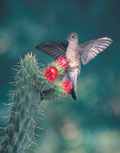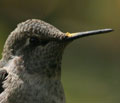Size
 Giant hummingbird Patagona gigasCredit: Luis Mazariegos(Size: 77.71 kb) |
Hummingbirds are distinct from other bird species by their size; they are the tiniest birds in the world. In fact, they are so small that they are sometimes confused with insects. Most species are between 5 and 22 cm in length. Species whose tails have long rectrices like the Giant Hummingbird (Patagona gigas) can be 35 cm long. The tiniest bird in the world is the Bee Hummingbird (Mellisuga helenae) living in Cuba, measuring 2.5 cm and weighing about 2 grams.
For information on other animal species resembling the hummingbird, follow this link.
Colours are a very effective sign for identifying hummingbirds.
Calls and songs at times help to differentiate hummingbird species.
The location
 21 hummingbirds at the same manger, not all the same species, New Mexico Credit: Harrison Frazier(Size: 40.26 kb) |
If you are in Manitoba, Ontario, Quebec or the Maritimes and you see a hummingbird, it is highly likely that it is a Ruby-throated Hummingbird (Archilochus colubris), because this is the only species found in these regions. If you are near the Alaskan border, it's a Rufous Hummingbird (Selasphorus rufus). But if you are on a trip near the equator, there are many possibilities. There are instances where a number of species frequent the same locations.
Males and females
 Anna's Hummingbird Calypte annaCredit: Nature display(Size: 40.43 kb) |
It is easier to identify males due to the more clearly defined differences in colouring than that of females. The majority of females have lacklustre colouring, no doubt an advantage for them when it comes to predators, especially when they set on their eggs and raise their young. Among females, the length and shape of the beak and colour patterns are used to identify the species.
Adult and immature birds
 Juvenile Ruby-throated Hummingbird Archilochus colubrisCredit: Serge Beaudette(Size: 111.88 kb) |
Adult hummingbirds are distinguishable from immature ones by their size and their colouring. Young birds are almost naked when they hatch. They have two minuscule rows of feathers on their backs. When they leave the nest, 2 to 3 weeks after they hatch, Ruby-throated Hummingbirds have already grown a lot. In fact, when the nestlings leave the nest, they are adult size. The mother continues to feed them, beak to beak. During this period, the young birds resemble their mother, except that the throats of the young males are usually marked with dark, sometimes red, stripes. Thus, a hummingbird's age cannot be definitely determined simply by observation. At the end of the summer, the bird must be held to determine its age and sex with certainty. In the spring, before migrating north, immature birds moult completely and grow their adult plumage.
A new species?
 Anna's Hummingbird Calypte annaCredit: Emily Hoyer(Size: 83.67 kb) |
If you see a hummingbird with a very evident yellow or white spot, but can't identify it in field guides, it's most likely pollen. A number of species have traces of pollen on their foreheads, throats or beaks.
 For information on Canadian species, follow this link. |

